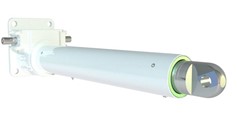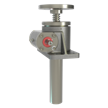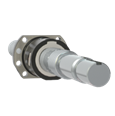Specialized Support for Government Projects
With over 50 years of experience in providing linear motion solutions and services to a vast array of defense and infrastructure projects, Nook has the unique capability to see a variety of customer requirements and contractual flow-downs. In this blog, Nook's most experienced technical contract expert, Dan Piltz talks about the in and outs of supporting government projects.
Project Requirements
Project requirements can range from a simple napkin sketch to full design documents with multiple pages of complex contractual requirements. Many of the requirements that aren’t even on a design print can greatly impact our product. In my career, I have been exposed to many of the DoD requirements. Let's review some of the common requirements we see at Nook and their impact on both cost and lead time.
Commercial-off-the Shelf
Let's begin with COTS (Commercial Off the Shelf). COTS can make things simple and easy if it applies. Almost every customer as well as the Federal Government have allowances for COTS items to be purchased as-is. For something to be COTS, it must be commercially available for anyone to buy. Our team knows that If someone would call up and ask for a part number out of the catalog and then apply pages of terms and conditions, it would be worth the discussion if it can be classified as COTS. Many of our projects involve levels of customization from a COTS product; often in this case it becomes a custom product subject to the applicable contractual requirements.


FAR and Buy American
There are many FAR systems (Federal Acquisition Regulation). Here is the government's own explanation “The FAR is a substantial and complex set of rules governing the federal government’s purchasing process.” They are basically the rules the United States Government implements on just about anything it purchases. To do business with the federal government, you must have a basic knowledge of FAR and how to use it. In addition, we often see the DoD’s special add-on, DFARS (Defense Federal Acquisition Regulation Supplement).
In 1947 the FAR got its start in the form of the Armed Services Procurement Regulation. In 1984 the FAR was formally codified and created a uniform structure for federal government procurement. The purpose of FAR is to ensure purchasing procedures are standard, consistent, and conducted fairly and impartially.
The FAR is issued and maintained jointly by the Secretary of Defense, Administrator of General Services, and National Aeronautics and Space Administration. Procurement Executives in DOD, GSA, and NASA are authorized to make revisions. The entirety of the FAR is over 2000 pages and the DFARS are additional 1500 pages (for reference an average novel book is 300-400 pages).
The entire FAR does not apply to every order, instead, when the government procures an item; various sections are applied and then flown down. I will address a couple we often see and what the means to Nook.
- 48 CFR § 252.225-7008 - Restriction on Acquisition of Specialty Metals. Many of our corrosion-resistant (stainless) steels fall under this clause. When we procure our raw material at the very start of the process, it must be manufactured in the United States or a qualifying country.
- 48 CFR § 52.225-1/26 – Buy American. In short, the title says it all. The majority of the product must be made in America or a qualifying country. They list methods to calculate the amount of foreign material used as well as the allowable percentage.
Fortunately, Nook’s standard business practice allows us to be compliant with most aspects of the FAR without additional effort. However, there are thousands of pages and clauses that can be applied to an order. These can range from special metals to texting while driving, even to combating human trafficking. Should any of them appear on a purchase order or terms and conditions, the Nook team knows to flag them for a compliance review.
While the Federal Government has an abundance of rules and regulations, they do try to keep it high level. Rarely, will they define how to process a product. However, within each customer's flow downs things can start to get more restrictive. As prime contractors receive orders, more and more restrictions can apply through each sub-tier supplier. Some of the more frequent clauses we see at Nook are things like, Approved Supplier List, NADCAP, and Locked Process.
Approved Supplier List
Every company has its business system that it works within. Nook has its own Approved Supplier List or ASL. An ASL is comprised of suppliers the customer company has certified as capable of supplying a service or product. It is not uncommon to have a purchase order be received with the requirements to use suppliers as listed on the ASL. This is important to note upfront because it can affect how the part is manufactured and what outside vendors are used. While there can be overlap between Nook and our customer's ASL, it can often require setting up a new outside vendor, gathering pricing and lead-time quotes to be compliant.
NADCAP
Some of our customers allow or require NACAP suppliers in place of the ASL. National Aerospace and Defense Contractors Accreditation Program – NADCAP is a worldwide program designed to manage special process suppliers. These suppliers have been certified under NACAP accreditation. This process requires them to meet the industrial or governmental standard for the process they supply. This means that any NACAP supplier should process parts to the appropriate standard every time, making one NADCAP supplier interchangeable with another.
Locked Process
The ASL and NADCAP are designed to ensure the end product is produced the same time every time. This is all part of a Locked Process. To better understand this, we need to take a quick detour into how the government qualifies a program. Getting a new program into production with the government is not a quick process. Once the idea is put out for bid the prime contractors will start their proposal. This proposal can include early RFQ’s to many of the sub-tier suppliers including Nook.
Early quotes are considered if the program is feasible. Once development is approved, we will see initial orders for development. These orders aren’t always subject to the flow downs and requirements. They are proof of concept ideas to see if the program will function as designed. If the design works and moves to the next stage, we will see qualification units. It is not uncommon to see several rounds of qualification. Each sub tier wants to test and qualify their product. This continues until the end product is tested and qualified by the Federal Government for approval.

Even in accelerated programs, final qualifications can take years to reach. That is where the Lock Process comes into play. Once units start going into qualification, if they work, don’t change it. Location, machines, tooling, and sub-tier suppliers are all some of the items that must remain the same from qualification through production. Of course, the government isn’t unreasonable and understands things change over the years. Each change after qualification must go through an approval process before being implemented.
These are just a few of the common things we see in programs that come from government funding, it is by no means an all-inclusive list. Nook strives to supply the most cost-effective and quality product to its customers. As a company, we are well versed in helping meet the needs of any customer from an economical commercial solution to a certified and qualified government program.
Dan Piltz is a Nook Senior Design Engineer. He also specializes in managing the technical aspects of government projects.
Need Linear Motion Support for a Government Project?
Contact one of our experts for further assistance:






